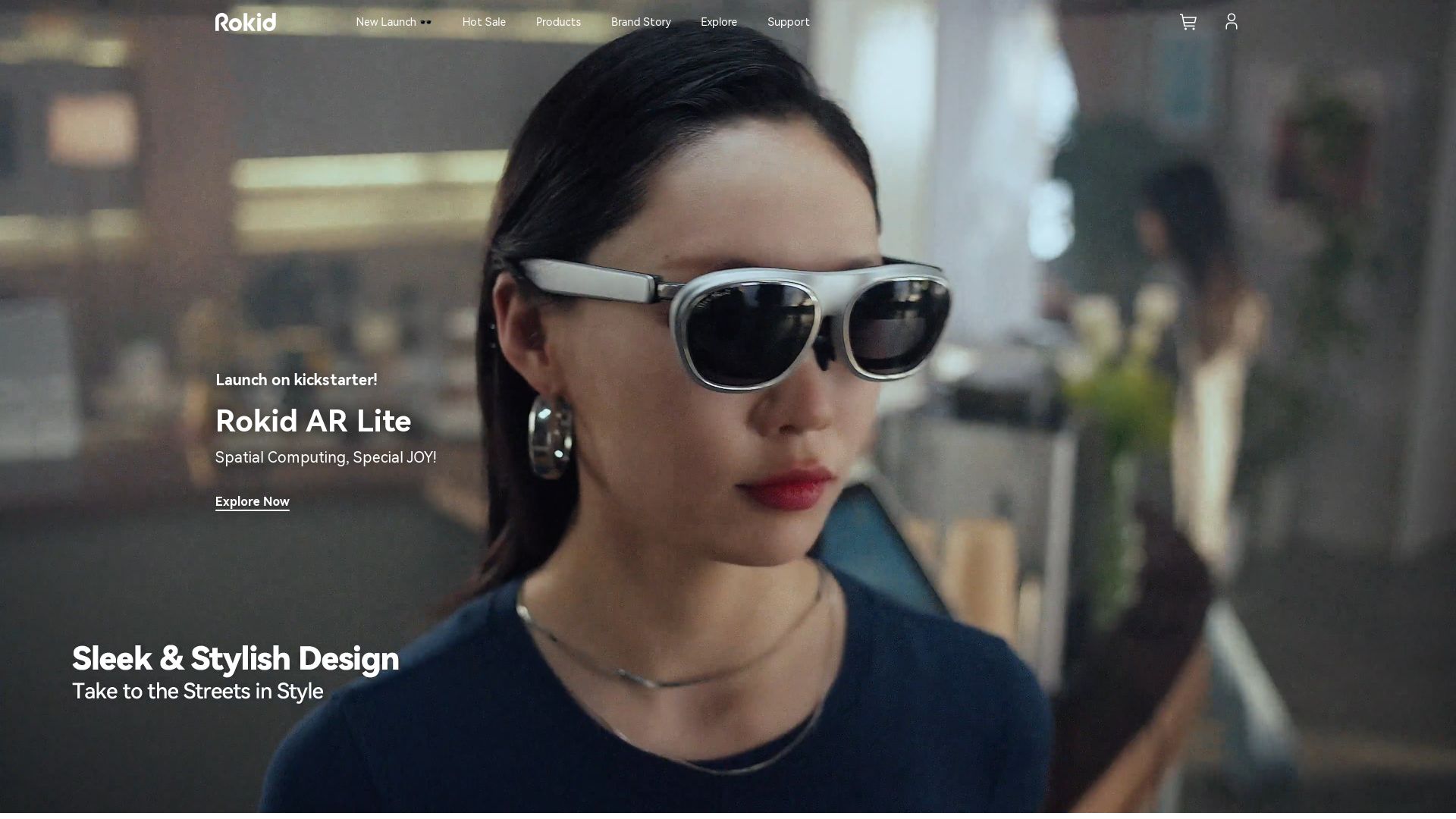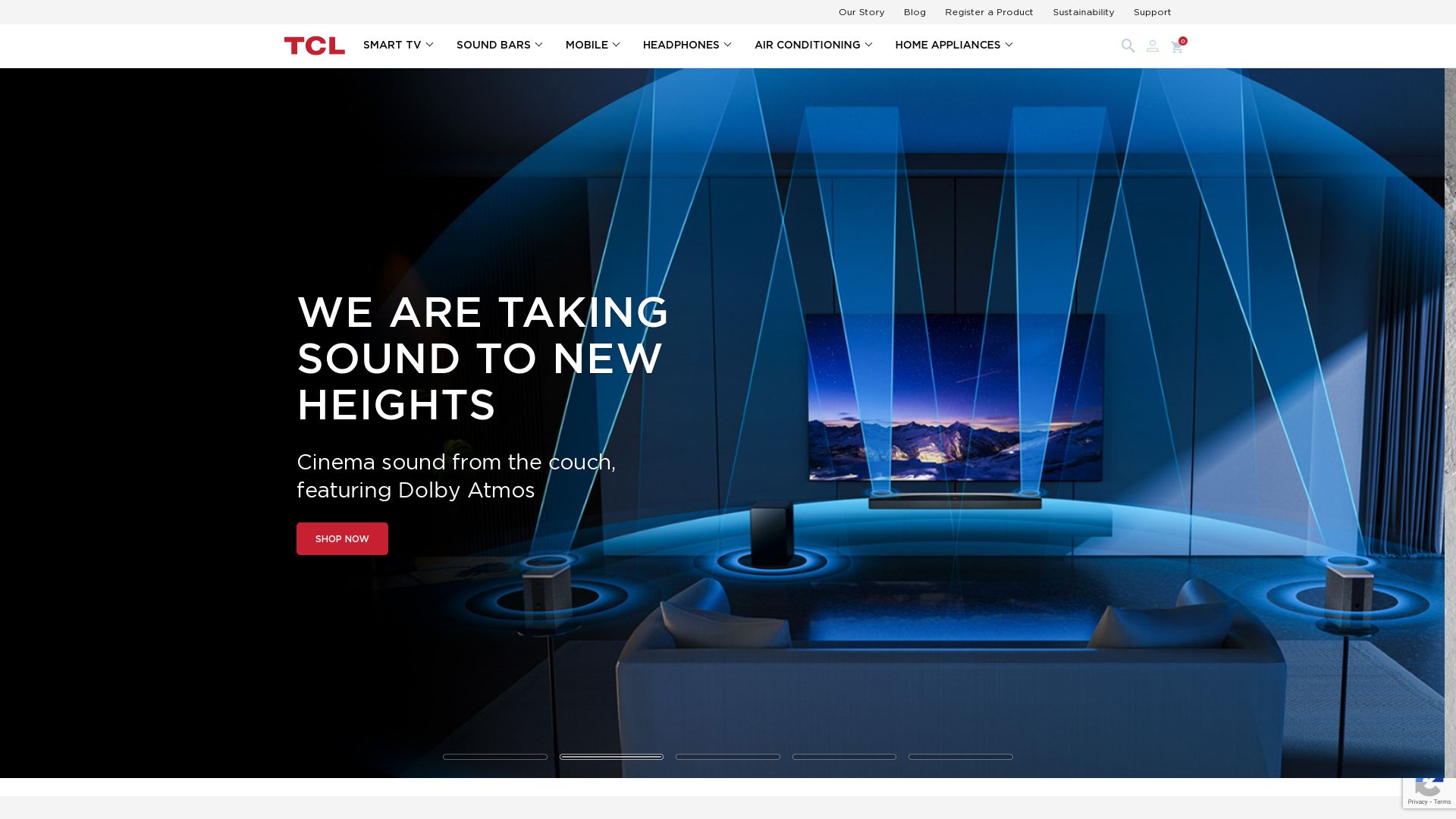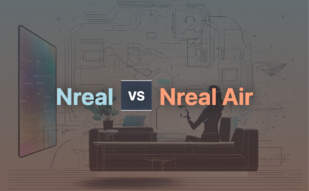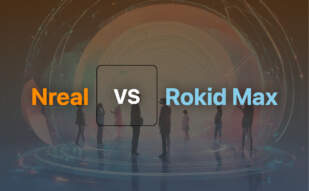Nreal is at the forefront of mixed reality technology, combining AR and VR for immersive experiences. Their technology integrates Spatial Anchors, Scene Understanding, and stereoscopic color Passthrough for a cutting-edge user interaction.

For those exploring options beyond Nreal, alternatives encompass Xreal, Rokid, Rokid Max, TCL, Vuzix, Virtue One, HoloLens, RealWear, Google Glass – each bringing a unique perspective to the AR/VR landscape.
Nreal Air
Introducing the Nreal Air AR glasses, a groundbreaking product from China’s innovative AR company, Nreal. These glasses represent a landmark in AR accessibility, blending style, affordability, and functionality with an innate understanding of users’ digital diverse needs.
Top Features of Nreal Air
- Affordability: Priced at $379, providing an economical alternative to the pricier Nreal Light glasses.
- Portability: Boasts a lighter and smaller design than its predecessor, Nreal Light, with a weight slightly more than traditional sunglasses.
- High-quality Display: Offers a 1920 x 1080 separate display on each lens, akin to watching a 201-inch screen at 6m.
- Streaming Ability: Capable of streaming games from Android, Xbox Cloud Gaming, Steam and provides personal theatre for streaming services like Netflix and YouTube.
- Power Efficiency: Consumes 50% less power than Nreal Light, catering to an on-the-go lifestyle.
| Compatibility | Initial Android compatibility with later addition of iPhone compatibility via a $59 dongle. Also works with other Apple devices and Windows computers. |
| Connectivity | Can connect with phones, computers, and gaming consoles via a single USB-C cable. |
| Modes | Features two modes: Air Casting and MR Space, enhancing user experience. |
Nreal Air Limitations
- Requires continuous connection via cable to a high-end Android smartphone. Incompatibility with iPhones can be an issue for users.
- Relies on the power of the connected device due to lack of onboard battery or processing power, impacting the battery life of the connected device.
- Lacks cameras or sensors for true AR, limiting mixed-reality experiences.
Nreal Air Pricing
Offering a blend of sophistication and affordability, Nreal Air is priced at $379. While an iPhone compatibility dongle is available at an additional cost of $59, the core product’s competitive pricing remains a significant draw.
Nreal Air Use Cases
Use Case 1: Personal Theater
With its large field of view and streaming compatibility, Nreal Air can serve as a personal theatre, revolutionizing the way users view services like Netflix and YouTube.
Use Case 2: Gaming
For gaming enthusiasts, Nreal Air’s ability to stream games from Android, Xbox Cloud Gaming, Steam offers a unique, immersive gaming experience.
Use Case 3: Work
For professionals and digital nomads, Nreal Air’s capability to transform devices into multi-screen on-the-go workstations adds efficiency to their workflow.
Xreal

Introducing Xreal, the brainchild of gamer celebrity CaptainSparklez and ex-Activision exec Howard Marks. Renowned for developing the highly popular mobile game, Fortress Fury, Xreal prides itself on its significant audience presence, with 1.3 million downloads primarily through Maron’s community.
Xreal Top Features
- Conception by industry heavyweights including CaptainSparklez and Howard Marks.
- Successful launch of its first mobile game, Fortress Fury, registering over 1.3 million downloads.
- Direct input from user community in game features and adjustments.
- A committed team, with an average size between 5-7 people, for game development.
| Feature | Detail |
|---|---|
| Founder Influence | Direct involvement in creative direction, feature selection, and adjustments. |
| Game Launch Success | 1.3 million downloads predominantly from Maron’s audience. |
| Community Involvement | Active engagement and respect for fan interactions and suggestions. |
Xreal Limitations
- No explicit mention of diverse game offering, with a single game primarily presented to Maron’s following.
- Substantial user acquisition challenge as acknowledged by co-founder Howard Marks.
Xreal Pricing
Pricing details for Xreal’s offerings and services are not explicitly provided in the company summary.
Xreal Use Cases
Use case 1: YouTube Creators
With direct promotional advantage through the following of CaptainSparklez, Xreal can be an attractive platform for other YouTube creators.
Use case 2: eSports Enthusiasts
Xreal, with Howard Marks at the helm, holds potential as an eSports landmark given Marks’ conviction about the imminent rise of eSports as a cultural phenomenon.
Use case 3: Mobile Gamers
Xreal’s proven success with mobile gaming, evidenced by Fortress Fury’s popularity, resonates well with the mobile gaming community.
Rokid

An innovator in the world of AR, Rokid blends artificial intelligence with sleek hardware to empower immersive experiences. Renowned for its AR smart glasses, the company sets the standard with comprehensive features, notably the RokidMax model.
Rokid Top Features
- FHD 1920×1080 pixel per eye resolution for high-definition viewing.
- 50° Field of View with 215″ borderless screen at 6 meters distance.
- Impressive 120Hz refresh rate for smooth visuals.
- Equipped with FHD Micro-OLED panel from SONY Semiconductor Solutions Corporation.
- Myopia adjustments between 0.00D and -6.00D, catering to a wider range of users.
- Low blue light, glare, and flicker-free display enhancing eye comfort.
- High-quality HD Directional Speakers coupled with Noise-canceling Microphones for optimal audio.
- Switchable 2D/3D content; can interface with phone, PC, console.
| Feature | Details |
|---|---|
| Contrast | 100000:1 |
| Color Gamut | sRGB 106% |
| Brightness | up to 600 nits |
| 9-axis (IMU)3DoF head tracking | enhanced performance |
| Weight | 75g |
Rokid Limitations
- Product runs on the older Android 6.0 version, limiting modern functionality.
- May require invasive app permissions, which could raise privacy concerns for some users.
Rokid Use Cases
Use case 1: Field Services
With lightweight designs like Rokid Glass 2, professionals in field services can benefit from increased efficiency and real-time access to crucial data.
Use case 2: Industrial Settings
The X-Craft, an industrial 5G explosion-proof MR glass, enables AI-powered inspections, powering a digital approach to workplace safety.
Use case 3: Visual Aid for Low-Vision Patients
Rokid’s Air Pro model, augmented with Eyedaptic’s software, aims to revolutionize visual aids for individuals with low vision.
Rokid Max

Peering into the universe of alternative Augmented Reality devices, we stumble upon the Rokid Max, an AR smart glasses designed to open up a deeply immersive universe right before your eyes. Poised on a balance of efficiency and aesthetics, Rokid Max integrates compact technology, quality, and user-friendliness, propelling itself into one of the viable alternatives for Nreal users.
Rokid Max Top Features
- Screen: Pair of Sony Full HD (1,920 x 1080) micro-OLED panels, a 215-inch virtual screen projected 6 meters away from the wearer, 50-degree field of view, and 120-Hz refresh rate.
- Hardware: 18.5-mm, weight 75 g, Titanium casing, includes 9-axis IMU, 3DoF head tracking, and wearing detection sensors.
- Adjustable Settings: 600 nits brightness with six adjustment levels, myopia adjustment feature from 0.00D to -6.00D, 90% light leakage reduction, and TÜV Rheinland Low Blue Light, Low Glare, Flicker Free, and EyeComfort Certified.
- Connectivity: Compatible with devices with USB-C DisplayPort and OTG (Android 10 or later), major game consoles, and PCs with HDMI port. Rokid Hub enables plug and play with Nintendo Switch.
- Audio: Two directional speakers integrated, pair of noise-canceling microphones, and wireless adapter.
| Extra Features | Benefits |
|---|---|
| HDMI to USB-C Adapter compatibility | Effortless connectivity enhancing the gaming experience. |
| Product available for worldwide shipping | An accessible option for AR enthusiasts across the globe. |
| HDCP support for seamless streaming | Unhampered video experience without the headaches of buffering issues. |
Rokid Max Limitations
- Limited to devices with USB-C DisplayPort and OTG (Android 10 or later).
- Myopia adjustment feature capped to -6.00D might alienate users with higher values.
Rokid Max Pricing
Retailing at $499 on Knoxlabs, and available for pre-order at $599, Rokid Max offers a competitive pricing strategy in a sea of AR hardware.
Rokid Max Use Cases
Gaming Enthusiasts
With compatibility across major game consoles and PCs with HDMI ports, and HDCP support for seamless streaming, the Rokid Max caters to the immersive gaming dreams of virtual reality enthusiasts.
Professionals
Offering a Micro-OLED display, low blue light, and flicker-free certification, Rokid Max serves professionals requiring extended screen times, delivering detailed graphics without straining their eyes.
Myopia Sufferers
Equipped with a customisable myopia adjustment feature, Rokid Max reaches out to a wider demographic of users, ensuring a comfortable and personalised viewing experience.
TCL

Enter the realm of Augmented Reality with TCL, an eminent stalwart in the spheres of AR/VR content marketing. Recongized for developing disruptive technology, TCL serves as the prime choice for creating richly interactive 3D applications—ranging from video games and animated films to TV series and visual effects.
Key Features of TCL
- Acclaimed Node-Graph Architecture: Provides a visual representation based on a network of interconnecting nodes, facilitating a streamlined navigation.
- Compatibility with Major Game Engines: TCL’s system is capable of importing 3D models to superior game engines namely, Unreal Engine and Unity.
- Advanced AiPQ Engine™: Harnessing machine-learning technology for an optimized 4K HDR visual experience, making the graphics come alive.
- Immersive Gaming Performance: TCL’s design supports low input lag, 144Hz, and AMD FreeSync Pro, offering seamless gaming experiences.
| Feature | Benefit |
|---|---|
| TV Sets | Large screens, optimized for smooth gameplay with full-suite 4K HDR for ultimate clarity and detail. |
| Conjoining with Alto Sound Bar | Creates a cinematic gaming experience with enveloping Dolby Atmos® 3D audio. |
| Autodesk Maya Compatibility | A powerful 3D computer graphics application, amplifying the creation of assets for interactive 3D applications. |
Limitations of TCL
- High contrast visuals: Although mainly a plus, it may occasionally cause visual strain over long hours of usage.
- Platform adaptability: Some issues may arise considering the software compatibility across a wide gamut of operating systems.
TCL Use Cases
1. CGI Filmmaking
TCL has excelled in the domain of CGI filmmaking. Its contribution has been vital in the development of every winning film for the Best Visual Effects Academy Award since 1997. Moreover, its role in creating the Disney film, Dinosaur, can’t be undermined.
2. Video Game Development
TCL proves imperative for video game development with its ability to import 3D models to leading game engines, thus enhancing the gaming landscape with lifelike HDR and billion brilliant colors.
3. AR/VR Content Marketing
For AR/VR content marketing, TCL is indispensable. With TCL’s AiPQ Engine™, the experience of AR/VR is intensified, leveraging machine-learning for an optimized 4K HDR visual experience.
Vuzix

Founded in 1997, Vuzix is a Rochester, NY-based Augmented Reality and wearable technology company recognized through a series of innovation awards from CES 2005 to 2023. Vuzix specializes in manufacturing wearable display technologies and has a vast offering involving VR and AR solutions.
Vuzix Top Features
- Waveguide Technology: Treasured for pioneering waveguide technology in their offerings, a method also used by Magic Leap.
- Blade: Their renowned Blade smart glasses serve as phone accessories, projecting a semi-transparent rectangular screen for phone notifications and lightweight app usage.
- Second Generation: Upgraded Blade 2 with Android 11 OS, improved memory management, and enhanced WiFi features.
- AR for Work: Specially designed for the deskless workforce, the Blade products connect frontline workers to AR systems, providing hands-free access to data and remote expertise.
- Remote Capabilities: Empowers remote support and teleconferencing applications.
| Investor Confidence: | Vuzix won the trust of giants like Intel which owns 10% of their stocks and has funding through State Street KOMP ETF at 12%. |
| Longevity and Patents: | With a history dating back to 1997 and holding 259 patents in the video eyewear field, Vuzix has a strong foothold in the wearable tech industry. |
| Consumer Flexible: | The recently launched Ultralite smart glasses, designed for consumer markets. A lightweight product that runs for two days and provides efficient, wireless technology. |
Vuzix Limitations
- Price: At $999.99, Vuzix’s Blade may be pricey for some consumers.
- Modified Accessory: Blade serves as a phone accessory rather than a comprehensive AR device, limiting full functionality.
- Display Limitations: Projects a smaller, semi-transparent rectangular screen limiting the user experience.
Vuzix Pricing
The current price for the Blade model is valued at $999.99, offering integration with Google Assistant and Amazon’s Alexa.
Vuzix Use Cases
Use case 1: Consumer markets
The new Ultralite smart glasses are perfect for the consumer market, especially for individuals seeking a lightweight AR solution for everyday uses like language translation, closed captioning, messaging, and direction provision.
Use case 2: Frontline Workers
Vuzix’s AR solutions allow frontline workers to access data hands-free and tap into remote expertise, making it an ideal worker companion in industries like healthcare, logistics, and field operations.
Use case 3: Gaming
With products like the Android-based smart glasses M100, users can connect to the Internet and play immersive AR games, making Vuzix an enticing option for the gaming community.
Virtue One
Virtue One is at the forefront of the XR sector, offering compelling AR, VR, and MR experiences. With over $3m crowdfunded on Kickstarter, the company’s product stands firmly as one of the finest XR glasses currently on the market, opening new dimensions for digital inclusivity and artistic expression around the globe.
Virtue One Top Features
- Trifecta of AR, VR, MR technologies, allowing for a diverse range of immersive experiences
- Simulated image projection of a 120-inch screen that overlays onto the real-world view
- Portable monitor capabilities thanks to its USB-C connectivity
- Full HD resolution at 60 fps playback with a contrast ratio of 50,000:1 with a micro OLED display
- Adjustable focus through a diopter dial above each eye (0.0D to -5.0D)
- An Electrochromic film for lens darkening, further enhancing the viewing experience
- Various device compatibility inclusive of laptops, smartphones, Nintendo Switches and Steam Decks
- Forthcoming planned features including a Bluetooth-compatible neckband for wire-free streaming
| Feature | Description |
|---|---|
| Optional Neckband | Enhances the experience by allowing for cloud gaming, remote console play and streaming |
| Mobile Dock | Creates extra device compatibility, seamlessly linking to your portable devices |
Virtue One Limitations
- Design Distractions: The glasses might sit noticeably far down the nose and could be uncomfortable
- Pending Improvements: Not all features, such as the neckband, are available yet
- Quality comes at a price: Considered pricier than other options available in the market
Virtue One Pricing
With a launch suite including all components priced at $677, the glasses alone are tagged at $549, positioning Virtue One towards the premium side of the spectrum. Adapters for the Nintendo Switch and Steam Deck are sold separately, enhancing its versatility and value proposition.
Virtue One Use Cases
Use case 1
Perfect for digital artists and designers intrigued with augmented, virtual, and mixed reality; Virtue One’s myriad features offer a unique canvas to bring creative ideas to life.
Use case 2
Gamers can enjoy an immersive gaming experience unlike any other. Compatible with popular handheld consoles, Virtue One takes cloud gaming and remote console play to a universal level.
Use case 3
Virtue One is a boon for tech enthusiasts around the world who value having their devices – laptops, smartphones, Nintendo Switch and more, in sync with their AR/VR/MR glasses for a unified digital experience.
HoloLens
At the frontlines of AR innovation, we have Microsoft’s HoloLens, a mixed reality device that’s been transforming various industries like healthcare, manufacturing, and education since its inauguration in 2015. Now onto its second iteration, the HoloLens 2, this self-contained holographic device continues to elevate enterprise operations with its unique feature set and robust applications.
HoloLens Top Features
- Ergonomic and untethered design, empowering users without limiting mobility
- Immersive spatial audio technology and biometric recognition for an optimized user experience
- Features like holograms and voice control (Cortana) tightly integrate into Microsoft Azure cloud services
- Eye tracking technology enhances usability, providing an instinctual user interface
| Feature | Benefit |
| Compatible with Trimble’s SketchUp Viewer, Microsoft Teams, Autodesk’s FreeForm software | Allows multiple applications for AR maintenance, secure live video feeds, and 3D design visualization |
| Integration into hardhat systems | Ensures safety during hands-on work in various industries |
HoloLens Downsides
The HoloLens has high-end features but it also comes with some limitations:
- High level of complexity might present a steep learning curve for newcomers to AR technology
- Device cost may act as a barrier for individuals or small businesses
HoloLens Pricing
The standard version of the HoloLens comes at a price point of $3,500, while the Industrial Edition is costlier, positioned at $4,950 – an investment for those who recognize the edge offered by AR in their field.
HoloLens Use Cases
Use case 1: Healthcare
The HoloLens has found significant usage in the healthcare industry. Medical startup ApoQlar uses holographic visualizations for explaining surgical procedures to patients, whereas MEDIVIS uses the device for easier surgery planning.
Use case 2: Education
Schools and universities are leveraging the HoloLens for interactive academic curricula, such as 3D modeling with HoloStudio, and human anatomy and neuroanatomy modules.
Use case 3: Engineering
In the field of engineering, the HoloLens is utilized as a precision-focused tool for complex designs. Lockheed Martin, for instance, applies the technology for precision in deep-space vehicle construction.
RealWear
RealWear is a renowned player in the AR space, specializing in industrial application solutions such as manufacturing, telemedicine, and logistics. Their products are designed for frontline workers, offering hands-free and voice-controlled functionality.
RealWear Top Features
- HMT-1Z1: This AR device meets safety standards for even hazardous environments.
- High-Resolution Micro Display: Provides a visual experience comparable to a 7-inch tablet, reposition-able for task visibility.
- RealWear Cloud: Centralized device management, streamline updates and real-time tech support.
- Hardware Integration: Functionality with Zoom, TeamViewer software, among others.
| Device | Key Feature |
| Navigator 500 | Assisted Reality AR glasses for frontline workers |
| Navigator 520 | 20% larger HD screen |
| RealWear Devices | PPE compatible, 4 noise-cancelling microphones |
RealWear Limitations
- Devices can be expensive, limiting accessibility for smaller organizations.
- Limited battery life (5 hours), requiring frequent recharges during long working days.
- Temperature limitations, not built for extreme conditions outside the -20 to +50 degree Celsius range.
RealWear Use Cases
Use Case 1: Manufacturing
RealWear‘s voice-controlled and hands-free devices reduce the risk of equipment drops, providing an edge for workers in manufacturing. Documentation can be securely synced via QR codes, allowing hands-on control while referring to manuals.
Use Case 2: Telemedicine
With RealWear‘s high-resolution camera, wireless connectivity and 4 noise-canceling mics, accessibility to experts, and mentors has revolutionized telemedicine. Health professionals can record videos, capture images and easily consult digital workflows.
Use Case 3: Logistics
RealWear devices support digital workflow applications in the logistics sector, minimizing bottlenecks and downtime via remote, real-time tech support. Also, the integration is possible with 3rd-party platforms for wider data aggregation.
Google Glass
Enter the revolutionary world of Google Glass, the wearable, voice-and-movement-controlled device that redefines augmented reality, bringing digital information right into your visual periphery with style and finesse.
Google Glass Top Features
- Integrated Experience: Displaying real-time updates, it supports motion and voice recognition commands ensuring fluid and seamless operation.
- Enhanced Connectivity: Ready-built Wi-Fi/Bluetooth connectivity, enabling instant sharing of captured photos/videos via Google Hangouts and more.
- Greater Accessibility: Offers access to Google search engine, translations streamed right to your screen, set visual reminders, simple sync with your phone/computer calendars.
| Real-time Updates: | Keep your world updated using Google Now. Experience the ease of living with instant access to essential info. |
| Voice/Video Calls: | Stay connected, respond to emails/texts via voice dictation. Effortless multi-tasking is here. |
Google Glass Limitations
- There were initial privacy concerns raised upon its release in 2013 which resulted in a standing-still period of around two years.
- It relies heavily on integrated systems for the seamless experience it promises, which could become cumbersome if you’re not within the Google ecosystem.
- It provides a semi-transparent screen, although innovative, might take time to get accustomed to.
Google Glass Use Cases
Use Case 1 (Factories)
At factories, Google Glass has become a game-changer. Real-time on-screen instructions and feedback could greatly increase efficiency and safety parameters.
Use Case 2 (Warehouses)
The touch-free, information-rich Google Glass interface makes it a perfect fit for warehouses, improving inventory management while saving time and cost.
Use Case 3 (Hospitals)
Google Glass enhances healthcare precision with instant access to patient data and medical info. Transforming patient care to a new level of proficiency.
Grant Sullivan
Content writer @ Aircada and self proclaimed board game strategist by day, AI developer by night.





